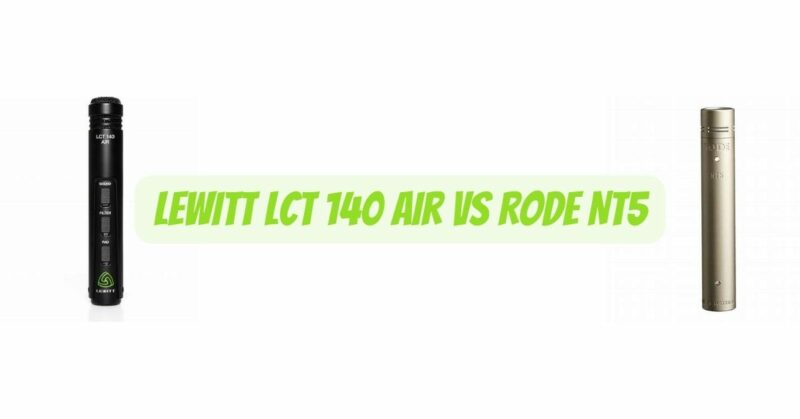When it comes to compact condenser microphones, the Lewitt LCT 140 Air and the Rode NT5 are two popular choices among audio professionals and recording enthusiasts. In this article, we will explore the features, specifications, and performance of these microphones to help you make an informed decision based on your recording needs. Whether you’re capturing acoustic instruments, vocals, or overheads, both the Lewitt LCT 140 Air and the Rode NT5 offer exceptional sound quality in a compact form factor.
Design and Build Quality: Both the Lewitt LCT 140 Air and the Rode NT5 are meticulously designed and built to withstand the demands of professional recording environments.
The Lewitt LCT 140 Air features a sleek and modern design with a robust metal housing. It incorporates Lewitt’s proprietary Air technology, which enables three switchable sound characteristics, allowing you to tailor the microphone’s response to different recording situations. The microphone also features a three-position low-cut filter and a pre-attenuation pad, providing further flexibility in capturing various sound sources accurately.
In comparison, the Rode NT5 sports a more traditional pencil-style design. It also has a sturdy metal construction, ensuring durability and reliability. The NT5 features a fixed cardioid polar pattern, making it well-suited for capturing detailed sound sources with excellent off-axis rejection. The microphone also comes with a high-pass filter and a pad switch, expanding its versatility in different recording scenarios.
Sound Quality: Both the Lewitt LCT 140 Air and the Rode NT5 deliver exceptional sound quality, capturing the nuances and details of various sound sources.
The Lewitt LCT 140 Air boasts a transparent and accurate sound reproduction, thanks to its wide frequency response and low self-noise. With the Air technology, you can switch between three sound characteristics: Linear, Gentle, and Enhanced. Linear offers a natural and uncolored sound, while Gentle enhances the microphone’s proximity effect for a warmer tone. Enhanced, as the name suggests, adds a slight boost to the high frequencies, providing a more pronounced presence in the mix. This versatility allows you to adapt the microphone’s response to different instruments or vocal performances.
Similarly, the Rode NT5 delivers a detailed and precise sound capture with a flat frequency response. The microphone’s cardioid polar pattern ensures focused sound pickup while minimizing background noise. The NT5’s extended frequency range and low self-noise contribute to its ability to faithfully reproduce the nuances of instruments and vocals, making it an excellent choice for critical recording applications.
Applications and Versatility: Both the Lewitt LCT 140 Air and the Rode NT5 excel in various recording applications, offering versatility and high-quality performance.
The Lewitt LCT 140 Air is well-suited for a wide range of recording scenarios. Its switchable sound characteristics allow you to tailor the microphone’s response to specific instruments or vocal performances. The Linear mode is ideal for capturing acoustic instruments and vocals with transparency, while the Gentle and Enhanced modes add coloration and character when desired. The LCT 140 Air performs exceptionally well as drum overheads, acoustic guitar miking, and even for capturing vocals in studio or live settings.
The Rode NT5, with its fixed cardioid polar pattern, is particularly well-suited for detailed instrument recording, including acoustic guitars, pianos, strings, and percussion. Its focused pickup pattern and extended frequency response ensure accurate and faithful sound reproduction. The NT5’s compact size also makes it a popular choice for stereo recording techniques such as XY or ORTF, where capturing the stereo image is essential.
Price and Value: The Lewitt LCT 140 Air and the Rode NT5 are both priced competitively, considering their exceptional sound quality and build craftsmanship. The choice between the two will ultimately depend on your specific recording needs, preferences, and budget.
Conclusion: In conclusion, both the Lewitt LCT 140 Air and the Rode NT5 are highly capable compact condenser microphones that deliver exceptional sound quality in a small form factor. The Lewitt LCT 140 Air offers the added flexibility of switchable sound characteristics, allowing you to tailor its response to different recording situations. On the other hand, the Rode NT5 provides a detailed and precise sound capture with a fixed cardioid polar pattern.
When choosing between the Lewitt LCT 140 Air and the Rode NT5, consider the specific instruments or sound sources you intend to record, as well as your desired tonal characteristics. Both microphones offer excellent value for their respective price points and are trusted choices for professionals and enthusiasts seeking reliable and high-quality sound reproduction.


